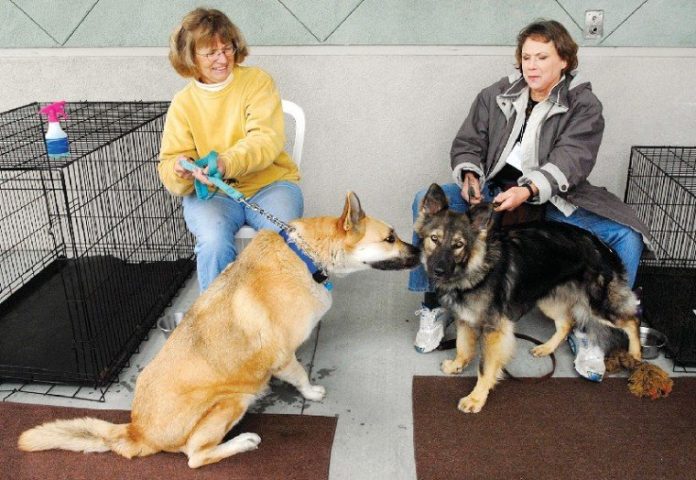Bob Jachens’ house sits on a large plot of land south of Gilroy
between horse farms and ranch houses. There is dirt to dig,
wildlife to chase and manure to smell. For a dog, this is
heaven.
Bob Jachens’ house sits on a large plot of land south of Gilroy between horse farms and ranch houses. There is dirt to dig, wildlife to chase and manure to smell. For a dog, this is heaven.
Yet all four of Jachens’ dogs – like many of the hundreds of dogs he helps place in homes across South County and the Peninsula as area manager for the German Shepherd Rescue of Northern California – were once in something close to hell.
Rinney, a nervous young male shepherd that shies away from humans, was found chained to a tree in the backyard of a house that the owners had moved out of many days earlier.
Dusty – a 2-year-old male shepherd that excitedly flings a rock from one end of the yard to the other, then chases them – came into the pound emaciated with three skin infections, patches of fur missing and infections in both ears.
Ending up turned out on the street or surrendered to kennels is not uncommon for German shepherds – smart, strong dogs that can grow to 130 pounds within a few years.
“The main age frame of dogs we pull out of the shelter are 1- to 3-years-old,” said rescue foster parent and Gilroy resident Melanie McNeil. “They probably got put there because they grew out of the cute puppy stage.
Nobody trained them at all so you get a strong male or female dog with no manners and pulling on the leash.”
This is where Jachens, McNeil and dozens of other South County volunteers come into the picture. The foster parents take in these rag-tag shepherds from animal shelters across the Bay Area and house them for an average of more than three weeks. Jachens, a geologist with the United States Geological Survey, estimated he spends 35 hours each week with rescue dogs.
The rescue operation takes in and adopts out about 300 dogs each year across California, Jachens said. In South County and the Peninsula, Jachens has overseen the adoption of more than 300 dogs in the past 3-1/2 years.
While the dogs are in foster care, volunteers tend to any health problems and teach them basic dog manners – sitting, not pulling on a leash, not jumping on visitors.
Foster parents also contend with separation anxiety or fear, which many dogs have because they are in new surroundings. The dogs often spend the first week whining at night and tearing up belongings during the day.
To make certain their efforts are not put to waste, and to make sure the dogs do not get abandoned again, volunteers vet out potential adopters. The volunteers first create a profile of the dogs’ characteristics – such as energy level, independence and size – and match them up with the desires of the adopters – such as guard dog or running companion.
“If we place a dog incorrectly, the dog can’t dial 911 and complain about it,” Jachens said. “It’s stuck. So we make an effort to be a rigorous. These dogs have been through a lot by the time we get them and we don’t want to add to that load.”
Volunteers also make certain adopters know they will have to put in work to help their dog adapt. Despite efforts by volunteers, the dogs usually have emotional problems that take training to eliminate.
“Very few of the dogs develop something that makes them unadoptable,” Jachens said. Still, “if you think you’re getting the perfect dog from us, then you better go somewhere else.”
Potential adopters visit the dogs at the foster home and, if an adopter likes a dog, the dog visits the adopter’s home. Though lengthy, the process results in six out of seven dogs finding a permanent home, Jachens said.
Adopters also appreciate the thoroughness of the process.
“It’s a great guarantee,” said Dyana Chargin, who adopted a 3-year-old female named Tessa two weeks ago. The volunteers “provide training, support. If it’s the wrong dog at the wrong time, they’ll take the dog back.”
Tessa – a stray picked up by animal control – was the fifth dog the family looked at, Chargin said. Though the dog was anxious the first two nights, it has calmed down and the family, which lives on a ranch in San Martin, has already bonded with it.
The San Martin Animal Shelter is unable to take the time to go through the rigorous adoption process due to the number of animals they receive, said Fletcher Dobbs, the county animal care and control program manager. The rescue operation is a welcome helping hand.
“They do absolutely have an effect on the number (of shepherds) that leave here as potentially adoptable dogs,” he said.
In addition, having the shepherds with foster families takes some of the stress off the shelter, which has to put animals to sleep when it is full.
“Any time we’re able to place an animal with an adoptive family or a rescue operation, it does free up a cage and potentially it does reduce the number of euthanasias we have to make,” Dobbs said.
The possibility of shepherds having to face this fate is what keeps many of the volunteers going, McNeil said.
After all, it’s not the dogs fault that they did not get an owner with enough foresight to see that they would grow larger than a puppy or an owner that would not take the time to train them.
“A lot of these dogs are just good dogs that didn’t have a chance,” she said.















